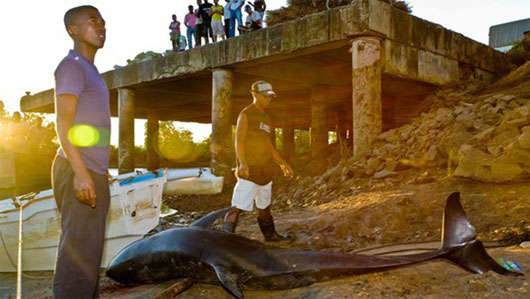Positioning waves cause whales to die in mass
When about 100 whales strayed into the shallow waters of Loza of Madagascar in May and June 2008, scientists suspected that underwater positioning waves played a role in this.
A group of independent scientists recently confirmed the relationship between underwater positioning waves, used by Exxon Mobil Corporation to map ocean beds for oil, with the death of ¾ of the early whales. lost.

More than 100 whales are stranded in Madagascar in 2008 - (Photo: IFAW)
When marine animals enter areas that they do not normally visit, such as shallow waters, it is the act of getting aground, dead or alive.
This is not the first study to confirm the link between locating waves and the state of stranded whales.
When about 150 head whales were washed into Hanalei Bay at Kaua'i Island in Hawaii in 2004, the US National Oceanic and Atmospheric Administration (NOAA) connected the event to the ship's wave underground of the US Navy.
NOAA's Southwest Fisheries Science Center in Pacific Grove, California, said it's unclear exactly why the whale changes behavior, but its organization expert Robert Brownel assumes that the sound of the wave "set up the sound wall, make them want to run away" , according to CBS News.
Others blame the lunar cycle, which triggers a runoff, based on 21 similar events, according to AFP.
However, with the new conclusion in Madagascar, human impact has clearly affected the normal activities of marine animals.
- Whales die mass, he suspects due to Russian submarines
- Whales drift ashore due to exercises
- Identify 337 stranded whales that change the Chilean bay
- The US investigated the 17 whales that died from ashore
- More than 300 dead whales in Chile's coast
- A series of mysterious whales on the Spanish beach
- Collective whales in New Zealand
- Whales die mass in Scotland
- The bodies of nine gray whales were discovered floating in California waters
- New method of calculating cosmic mass
- Whales die massively on the coast of New Zealand
- Ultrasound 'magic' of dolphins can improve current medical techniques
 Surprised: Fish that live in the dark ocean still see colors
Surprised: Fish that live in the dark ocean still see colors Japan suddenly caught the creature that caused the earthquake in the legend
Japan suddenly caught the creature that caused the earthquake in the legend A series of gray whale carcasses washed ashore on California's coast
A series of gray whale carcasses washed ashore on California's coast Compare the size of shark species in the world
Compare the size of shark species in the world